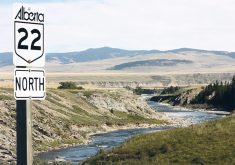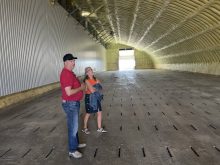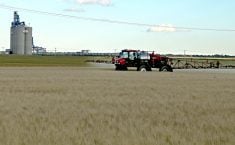The lush green growth in pastures and hay fields has not necessarily translated into more or better quality feed.
Saturated ground prevented producers from using some pastures and cutting hay crops at the optimum time. The warmer weather during the past two weeks has helped but feed quality is a concern.
Ituna, Sask., producer Bob Ivey said calves are coming off grass between 50 and 80 pounds lighter than usual because the grass was mostly water and lacked nutrients.
Art Pruim, who milks 380 cows at Osler, Sask., has also noticed a problem.
Read Also

New coal mine proposal met with old concerns
A smaller version of the previously rejected Grassy Mountain coal mine project in Crowsnest Pass is back on the table, and the Livingstone Landowners Group continues to voice concerns about the environmental risks.
“The quality of the feed is definitely down,” he told the Canadian Farm Writers’ Federation conference in Moose Jaw, Sask., Oct. 2. “Milk production is down.”
Feed specialists say this year has been a disaster for some.
Pam Iwanchysko, regional forage production specialist in Dauphin, Man., said this was the third year in a row that producers in the region around Ste. Rose du Lac, Man., were flooded.
In one day this year the area, which has a lot of low-lying land, received 280 millimetres of rain.
Producers couldn’t get their animals into pastures and they couldn’t hay, leading to a significant feed shortage.
“They are devastated,” she said.
Some are talking about reducing their herds because there won’t be enough feed.
Even those lucky enough to get into hay fields are facing poor quality.
“They haven’t been able to put it up without a rain, or two, or three,” Iwanchysko said.
Mould and mycotoxins are likely to appear in high-moisture bales, which will lead to production problems.
The ability of such feed to provide nutrition for pregnant cows is questionable.
“I am highly recommending that feed testing be done,” she said.
Saskatchewan feed specialist Barry Doig, who works out of the North Battleford office, said although he has seen only a small sampling of test analyses on alfalfa/brome so far, he said protein and energy are down, while fibre is up.
Protein is typically around 12 or 12.5 percent. This year, it’s nine to 9.5 percent. Energy, or total digestible nutrients, should return a value in the high 50s and low 60s, but this year the number is 52.
And neutral detergent fibre has come in at 70 percent or higher, when it should be between 42 and 44 percent.
Such results mean the feed is lacking nutrients and cattle have difficulty digesting it.
“The higher the fibre, the longer it takes to pass through,” Doig said. “They can’t eat as much.”
In the case of calves not gaining enough weight on wet pastures, Iwanchysko said that’s because the grass is so saturated.
It’s similar to when humans aren’t able to eat after drinking too much before a meal. They feel full but not with the right stuff.
Both specialists said proper rations are required. Protein and energy supplements will likely be in demand.
Iwanchysko said the recent warm dry weather has allowed some to take off good quality second cut alfalfa, which will help. But shortages are expected to persist.
“The only positive spin on this is that we might have a lot of feed grains available,” she said.
However, frost damaged feed is another concern.
Alberta Agriculture beef and forage specialist Barry Yaremcio said nitrates accumulate in greenfeed, with the highest concentration typically occurring four to five days after the frost.
Cutting the crop within a day of a light or injuring frost can prevent the roots from continuing to push nitrogen up from the soil into the damaged leaves.
“A killing frost completely destroys the entire system that moves nutrients up into the plant,” Yaremcio said in a news release.
“As such, a killing frost is better than a light one, as it eliminates the problem of nitrate accumulation.”

















